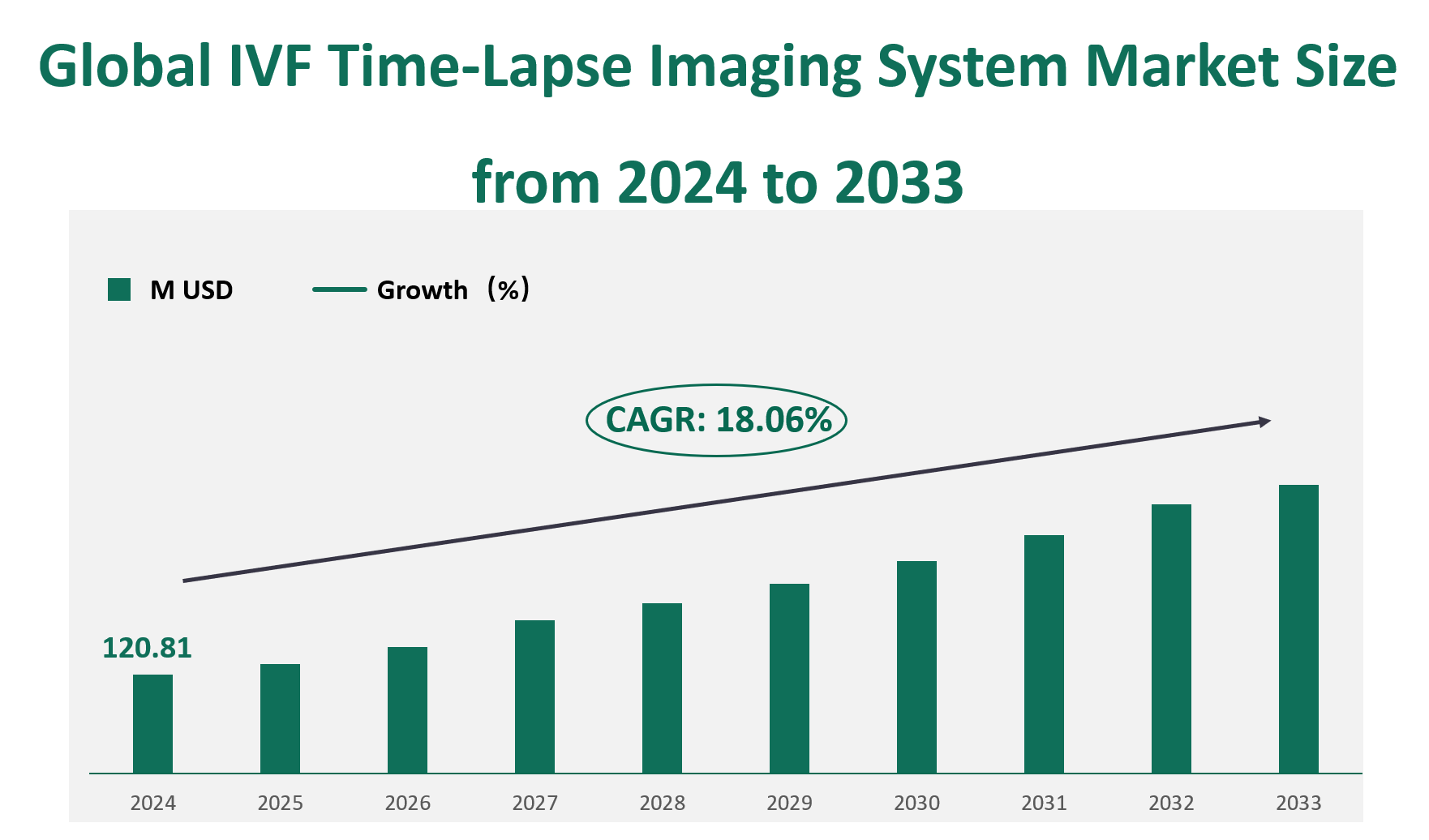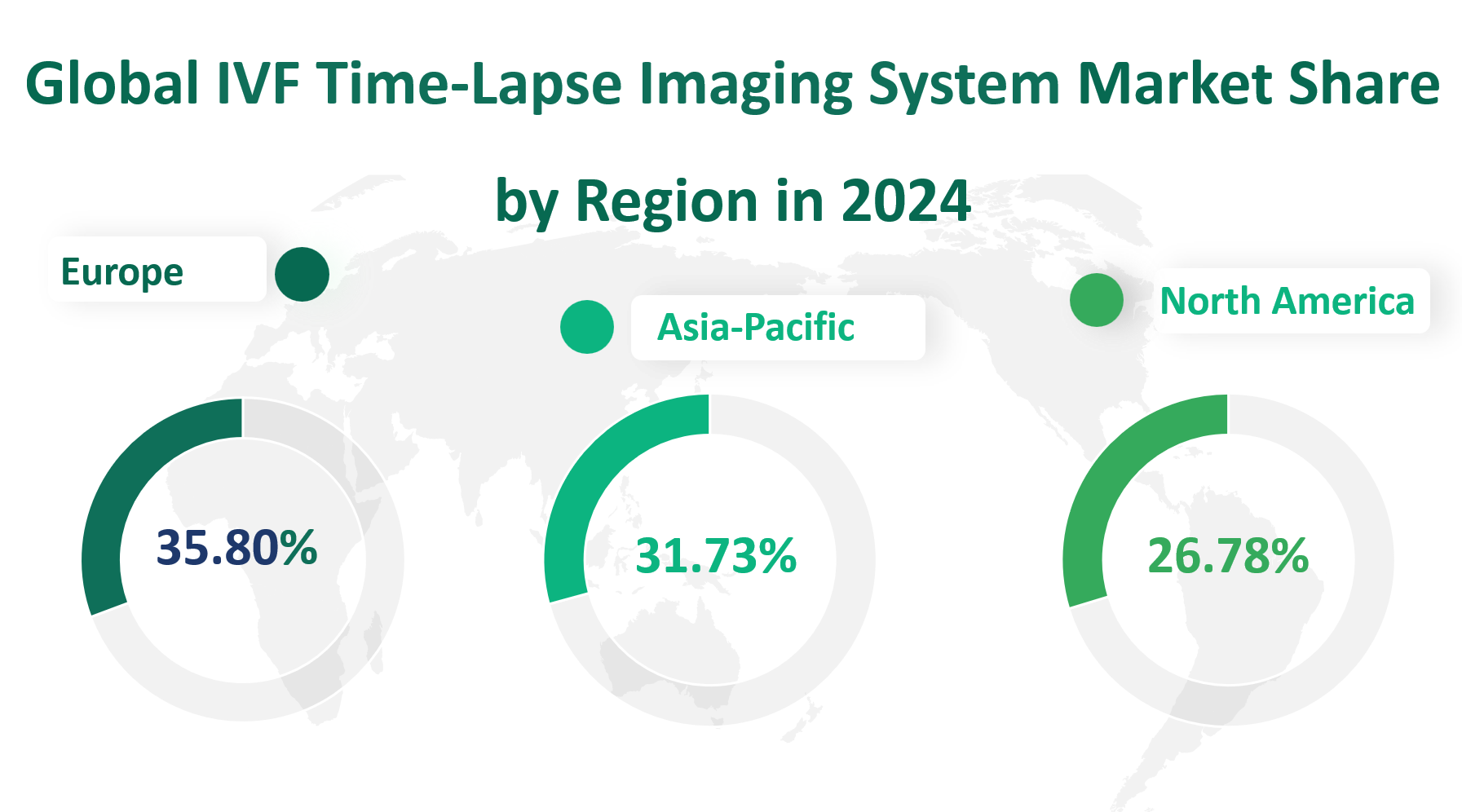1. Global IVF Time-Lapse Imaging System Market Insight Analysis
In 2024, the global IVF Time-Lapse Imaging System market size is estimated to reach approximately US$120.81 million, with a compound annual growth rate (CAGR) of 18.06% from 2024 to 2033.
An IVF Time-Lapse Imaging System is a sophisticated technology used in assisted reproductive technology (ART) to monitor and assess the development of embryos. This system employs time-lapse imaging technology to capture real-time photographs of embryos in an in vitro culture environment. Typically, images are taken at regular intervals (e.g., every 5 minutes), and these images are compiled into a dynamic video that records the entire development process of the embryo.
The technology allows embryologists to observe the embryos continuously without removing them from the incubator, thereby minimizing potential disturbances and providing detailed kinetic parameters that predict the embryos’ developmental potential. This information is crucial for selecting the most viable embryos for transfer, ultimately improving embryo implantation and clinical pregnancy rates.
The integration of advanced features such as artificial intelligence (AI) algorithms further enhances the system’s capabilities. AI can analyze the time-lapse images to predict which embryos are most likely to result in successful pregnancies, thereby aiding embryologists in making more informed decisions. This technology not only improves the efficiency of the IVF process but also enhances its success rates, making it an essential tool in modern fertility clinics and hospitals.
Figure Global IVF Time-Lapse Imaging System Market Size (M USD) and CAGR (2024-2033)

2. Driving and Limiting Factors of IVF Time-Lapse Imaging System Market Growth
The growth of the IVF Time-Lapse Imaging System market is driven by several key factors. Firstly, the increasing prevalence of infertility worldwide is a major driver. According to the World Health Organization (WHO), approximately 17.5% of adults globally suffer from infertility, a figure that has been rising due to factors such as environmental pollution, delayed childbearing, and increased life stress. This has led to a growing demand for assisted reproductive technologies (ART), including IVF, thereby driving the market for IVF time-lapse imaging systems.
Another significant driver is the increasing acceptance and awareness of IVF as a viable solution for infertility. Societal attitudes towards infertility and IVF have shifted in recent years, with more couples recognizing infertility as a medical condition that requires treatment. This shift has led to an increase in the demand for IVF procedures, which in turn has driven the market for IVF time-lapse imaging systems.
However, the market also faces several limiting factors. Economic downturns can reduce disposable income, making IVF treatment less affordable for many couples. Additionally, political instability can disrupt supply chains and limit access to healthcare facilities, thereby affecting the demand for IVF time-lapse imaging systems. Cultural and religious barriers also pose challenges, as certain beliefs may stigmatize infertility or object to the use of assisted reproductive technologies. These barriers can limit the adoption of IVF time-lapse imaging systems in certain regions or among specific patient groups.
3. Technology Innovation and Corporate Mergers and Acquisitions in IVF Time-Lapse Imaging System Market
Technological innovation is a key driver of the IVF Time-Lapse Imaging System market. The integration of artificial intelligence (AI) into these systems is a significant trend. AI algorithms can analyze time-lapse images to predict which embryos are most likely to result in successful pregnancies, thereby providing more accurate and objective information to embryologists. This technology not only improves the success rates of IVF treatments but also reduces the workload of embryologists by automating the analysis of time-lapse images.
Corporate mergers and acquisitions are also shaping the market landscape. For instance, Vitrolife Sweden AB completed the acquisition of Igenomix in 2021, which expanded its product portfolio and market reach. Similarly, Esco Group’s acquisition of AT Medical UAB in 2018 enhanced its capabilities in the IVF technology space. These strategic moves are aimed at strengthening market positions and driving further innovation in the field.
In addition to technological advancements and corporate strategies, the market is also influenced by regulatory and policy changes. For example, the gradual incorporation of IVF and other assisted reproductive technologies into medical insurance in countries like China is expected to increase market demand by making IVF treatment more affordable and accessible. This trend is likely to be replicated in other regions as governments recognize the importance of addressing infertility through accessible healthcare solutions.
4. Global IVF Time-Lapse Imaging System Market Size by Type
The IVF Time-Lapse Imaging System market is primarily segmented into two product types: Software and Hardware.
IVF Time-Lapse Imaging System Software refers to the suite of tools used for embryo decision support. These software solutions apply various standards and algorithms to analyze embryo development, providing detailed insights and predictions on the viability of embryos. The software can grade embryos based on their statistical feasibility and potential for successful implantation. In recent years, the integration of artificial intelligence (AI) has revolutionized these tools, enabling more accurate and objective assessments of embryo development.
In 2024, the market size for IVF Time-Lapse Imaging System Software is estimated at $12.07 million. While this segment is growing rapidly, it currently holds a smaller market share compared to hardware, accounting for approximately 9.99% of the total market.
Hardware
The hardware component of IVF Time-Lapse Imaging Systems includes the physical equipment used to capture and record time-lapse images of developing embryos. This typically consists of incubators equipped with built-in cameras that maintain optimal conditions for embryo growth while capturing images at regular intervals. The hardware is essential for providing the detailed morphokinetic data required for embryo selection and analysis.
The market size for IVF Time-Lapse Imaging System Hardware in 2024 is projected to be $108.74 million. This segment dominates the market, holding a significant 90.01% market share.
Table Global IVF Time-Lapse Imaging System Market Size by Type in 2024
5. Global IVF Time-Lapse Imaging System Market Size by Application
The IVF Time-Lapse Imaging System market is also segmented by its applications, primarily in Hospitals, Fertility Clinics, and Other applications.
Hospitals are a significant application area for IVF Time-Lapse Imaging Systems. These systems are used in hospital-based fertility centers to monitor embryo development, select the most viable embryos for transfer, and improve the success rates of IVF procedures. The technology also aids in quality control and patient education, providing detailed visual information about the development of embryos.
In 2024, the market size for IVF Time-Lapse Imaging Systems in hospitals is estimated at $23.63 million.
Fertility clinics are the primary application area for IVF Time-Lapse Imaging Systems. These clinics specialize in assisted reproductive technologies and rely heavily on advanced imaging systems to optimize their IVF procedures. The technology allows embryologists to track embryo development in real-time, select the best embryos for transfer, and improve clinical pregnancy rates. Fertility clinics are at the forefront of utilizing this technology to enhance patient outcomes and increase the success rates of IVF treatments.
The market size for IVF Time-Lapse Imaging Systems in fertility clinics in 2024 is projected to be $92.82 million. This segment holds the largest market share, accounting for 76.83% of the total market.
Table Global IVF Time-Lapse Imaging System Market Size by Application in 2024
|
Application |
Market Size (M USD) 2024 |
Market Share |
|
Hospital |
23.63 |
19.56% |
|
Fertility Clinic |
92.82 |
76.83% |
|
Others |
4.37 |
3.61% |
6. Global IVF Time-Lapse Imaging System Market by Top Regions
North America is a significant market for IVF Time-Lapse Imaging Systems, with the United States and Canada being the primary drivers. In 2024, the market size in North America is estimated at $32.36 million. The region benefits from advanced healthcare infrastructure, high awareness of IVF treatments, and a supportive regulatory environment.
Europe is the largest regional market for IVF Time-Lapse Imaging Systems, with a projected market size of $43.26 million in 2024. Key countries contributing to this growth include Germany, the UK, France, and Italy. Europe’s dominance can be attributed to its robust healthcare systems, high demand for advanced reproductive technologies, and widespread acceptance of IVF treatments.
The Asia-Pacific region is the fastest-growing market for IVF Time-Lapse Imaging Systems, with a projected market size of $38.33 million in 2024. Key markets in this region include China, Japan, South Korea, and Australia. The growth is driven by increasing infertility rates, growing awareness of IVF treatments, and the gradual incorporation of assisted reproductive technologies into medical insurance in countries like China.
Latin America is an emerging market for IVF Time-Lapse Imaging Systems, with a projected market size of $4.02 million in 2024. Key countries include Brazil and Mexico.
The Middle East & Africa region is also an emerging market, with a projected market size of $2.85 million in 2024. Key countries include Turkey, Saudi Arabia, and the UAE.
Figure Global IVF Time-Lapse Imaging System Market Size by Region in 2024

7. Global IVF Time-Lapse Imaging System Market Analysis by Major Players
7.1 Vitrolife Sweden AB
Company Introduction and Business Overview
Vitrolife Sweden AB is a leading medical device company headquartered in Sweden. Founded in 1994, the company specializes in developing, producing, and marketing products for creating, prolonging, and improving life. Its product categories include Oocyte retrieval Needles, Sperm processing, IVF media and oil, Micromanipulation pipettes, Labware, Benchtop incubators, Time-lapse systems, Preimplantation Genetic Testing (PGT), Cryopreservation, Laser and imaging systems, and Lab QC systems.
Products
Vitrolife’s flagship product is the EmbryoScope+ time-lapse system, which provides undisturbed stable incubation and constant time-lapse monitoring. The system includes advanced embryo analysis software tools that allow direct comparison of all embryos in a single interface, providing detailed morphokinetic data.
Sales Revenue in 2023
In 2023, Vitrolife Sweden AB reported a revenue of $56.52 million in the IVF Time-Lapse Imaging System business.
7.2 Genea Biomedx PYT LTD.
Company Introduction and Business Overview
Genea Biomedx PYT LTD. is a biotechnology company headquartered in Australia. Founded in 1985, the company specializes in the development and commercialization of fertility treatment technologies. Its flagship product is the Geri time-lapse imaging system, which captures images of developing embryos at multiple time points and provides real-time analysis using AI algorithms.
Products
Genea Biomedx offers a range of fertility products, including the Geri incubator with integrated embryo monitoring, Geri Connect & Geri Assessment software, and the Eeva™ Test software. These products provide detailed embryo development data and support decision-making for embryo selection.
Sales Revenue in 2023
In 2023, Genea Biomedx PYT LTD. reported a revenue of $9.62 million in the IVF Time-Lapse Imaging System business.
7.3 ASTEC CO., LTD.
Company Introduction and Business Overview
ASTEC CO., LTD. is a Japanese company specializing in the development, manufacturing, and sale of medical equipment and devices for assisted reproductive technologies (ART). Founded in 1978, the company offers a range of ART products, including IVF time-lapse imaging systems, incubators, and micromanipulation systems.
Products
ASTEC’s key product is the CCM-iBIS time-lapse imaging system, which features nine small incubation chambers and advanced imaging capabilities. The system uses the EmbryoGrid to optimize group culturing of embryos and provides detailed morphokinetic data.
Sales Revenue in 2023
In 2023, ASTEC CO., LTD. reported a revenue of $7.43 million in the IVF Time-Lapse Imaging System business.

